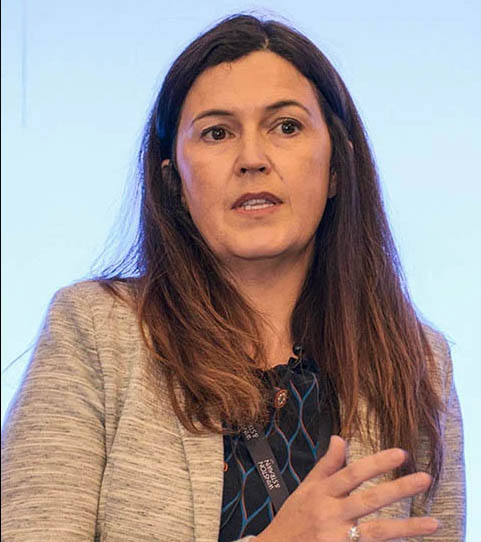
Dr Valérie Marcel
March 21 ,2021
While natural gas will significantly reduce emissions compared to current heavy fuels used here, Guyana needs to carefully study its future energy mix plan, taking into focus both the economics and environmental impacts, says Chatham House fellow Dr Valérie Marcel.
The project head of the New Petroleum Group, and whose experience includes advising governments on petroleum sector policy and governance, reasons that studies may show that the mix could vary from region to region, given its vast geographical makeup.
“In considering the option of bringing gas to shore, Guyana will need to study the economics carefully (will the gas be affordable to Guyanese utilities?), as well as any associated environmental impacts,” the Energy, Environment and Resources Programme fellow told the Sunday Stabroek. “And in doing so, it should compare those costs and benefits with those associated with renewables. It is really important to consider all the tradeoffs before deciding the right energy mix. The needs may also vary by region. While Georgetown is on a grid, the hinterland would benefit from renewables, which don’t require a grid,” she explained.
But with gas flaring continuing daily offshore at the ExxonMobil Liza-1 offshore field, Dr Marcel says that the company has to commit to not flaring anymore and ensure that it has adequate compression systems in place. She stressed that the company has to also be able to monitor for possible gas leaks in the future and urges government to have systems in place for its own monitoring. “I think the first response is that flaring of associated gas cannot continue. Exxon needs to abide by its own environmental standards as a member of the Methane Guiding Principles organisation, ensure that it installs adequate gas compression systems, and monitors gas leaks in future. Government needs to be monitoring this carefully as well,” she urged.
As he boasted of the prospects of what a gas-to-shore system could do for not only this country’s energy efficiency, President Irfaan Ali on Thursday said that the project will be a “major catalyst for industrialisation here…This will afford our Guyanese economy the opportunity to have an enhanced manufacturing sector and allow Guyana to become an industrial powerhouse, a model energy state, the breadbasket of the Region, the Silicon Valley of the Caribbean, and a sustainable tourism paradise,” Ali said.
With Ali’s government announcing that Wales on the West Bank Demerara had been selected for the landing of the project, former Petroleum Advisor Jan Mangal has said that government should show through sound justification that the location was not chosen just for political mileage. He declared that it should not only be the government making decisions, but the populace needs to also have an input into the project as it is of great national importance and will be funded by taxpayers.
“My concern about choosing any particular site now is that we do not know whether it is the best site. We have not performed the necessary feasibility study comparing various locations along Guyana’s coastline. We do not know if Wales is the best site, in terms of ground elevation or in terms of proximity to a future industrial zone, deepwater port and route to Brazil. In addition to providing electricity to Guyanese, electricity from the gas-to-power project should be used to develop a large industrial/manufacturing zone which would create tens of thousands of jobs.” Before any gas-to-shore project is embarked upon, Mangal contended that a detailed feasibility study is needed along with an analysis of whether renewable energy might not be a better option.
The former Petroleum Advisor said that if a decision is made to go ahead with the oil and gas project, its management should be entrusted to a reputable international agency given the high costs and risks entailed.
Urging the government to tap into resources previously offered for a detailed feasibility study on bringing its gas resources to shore in Guyana, Mangal lamented that thus far a “mere desk study” was done under the APNU+AFC government which handpicked Clonbrook on the East Coast of Demerara.
He underscored the need for detailed analyses and said that all studies should be made public and feedback received before implementation. Mangal said that the PPP/C government needs not be afraid to start afresh, since “covering all ends” is needed and it helps taxpayers who would have to repay “significant sums”, totaling billions of dollars, on a project that could very well be “another Amaila”, referring to the planned hydropower project which became mired in controversy and did not materialise.
Mangal had long advocated for bringing gas to shore for energy here, given this country’s high cost for power consumption and its dependency on heavy fossils along with the unreliability of the power system.
However, he said that with the climate change imperatives and the global move towards renewables, it would be prudent to weigh all the pros and cons before a decision was made.
Dr Marcel, who visited Guyana in March 2018 for an oil and gas forum and has followed developments here, shares similar views and posited that if there is too much associated gas, it can be reinjected into reservoirs offshore, “it could be valuable to Guyana’s energy mix to bring it to shore to generate electricity, as a complement to the buildup of renewable energy in the country”.
“The gas fired power would reduce emissions associated with the current practice of burning fuel,” she stated.
Chatham House is an independent policy institute based in London, UK.
